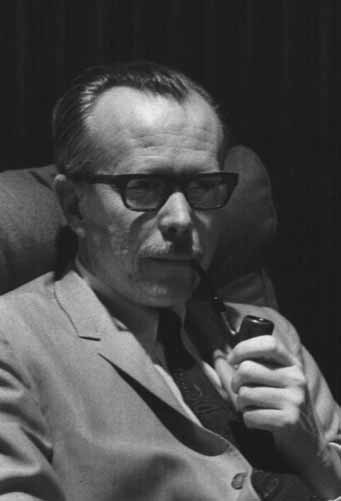Past Chairs of the Art History Department
These profiles honor and commemorate some departmental faculty members who have retired or passed away in recent years. Please contact the department if you would like to add a profile or contribute additional information or pictures.
Anthony D. King

When the Department of Art History posted the job description for a colleague who could bring a globally-attuned historical and critical perspective to the department––an advertisement that raised eyebrows in other art history departments at the time––it was remarked by one faculty member that they could think of only one person in the world able to fit the description. Thankfully, Tony duly applied, drawn to Binghamton, it must be said, by his interest in coming to the campus where Immanuel Wallerstein still presided over the Braudel Center. In a sense, he never quite got over his surprise at joining an art history department; for all that, over the years he was to do more than his share of departmental administration. Yet, if he arrived in thrall to world systems theory, at a time when he was writing his two volumes on global cities and the world urban system, the department was, in due course, to have its own impact on his trajectory, visible not least in the two “Current Debates in Art History” symposia that gave rise to two published collections, as well as in the fact that when it came time to give a title to the innovative series he edited for Routledge from 1999 on, he chose "Archi-Text." There was also the truly memorable 1989 visit by Cultural Studies founder Stuart Hall that Tony organized, and this, too, had an effect on prompting him to rethink his earlier dislike of “culturalist” approaches and to engage with new themes of identity, subjectivity and even textuality.
Perhaps we may not have succeeded in making an art historian of Tony––he was particularly irked by the national and period divisions that were so dear to the discipline and that lived on in the organization of the slide collection––but no one can be in any doubt that he more than met the charge of that original job description in leading us to reimagine what an art history program can and should be, notably transforming in the process not only the intellectual horizon of our graduate program but also the global reach of our graduate student body itself. Perhaps inevitably, this largely escapes the published tributes and remembrances, which focus on his larger scholarly contributions, but that does not mean that these recollections are merely parochial. Tony’s intellectual journey across his years at Binghamton belonged to the department as much as the department’s own journey belonged to him. We should be all the more grateful, therefore, for Nancy Um’s initiative in organizing the timely 2013 conference, “Writing the Global City,” that celebrated his work and teaching. That was the right time for reminiscence, reunion and acclaim. Now, sadly, we have to do another kind of remembering.
For those seeking a more detailed account of Tony’s achievements, a remembrance of his long and influential career was published in December 2022 in the online journal, PLATFORM. A ninetieth birthday tribute by Binghamton graduate and York University professor, Abidin Kusno (MA 1993, PhD 1998), also offers a richness of personal recollections as well as a comprehensive survey of the development of his thought and scholarship. (Remembrance written by John Tagg, SUNY Distinguished Professor of Art History)
Barbara Abou-el-Haj (1943-2015)

The Department of Art History mourns the untimely loss of Professor Barbara Abou-El-Haj––a dear friend and colleague to us all. For almost thirty years, with her open house and her open heart, Barbara made colleagues and students of the department an extension of her own family. And, in that period, an entire generation of students passed through her lectures and seminars, while her teaching and research added immeasurably to the national and international visibility of the program. It was in 1985 that Barbara came to Binghamton from UCLA, where she had completed her doctorate working with the renowned historian of medieval and modern art, Karl Werckmeister. The dissertation she wrote under Werckmeister's supervision became her 1994 book, The Medieval Cult of Saints: Formations and Transformations, which exposed the fierce competition between cults that characterized the political struggle to preserve property and privilege, especially in the eleventh and twelfth centuries. There were also path-breaking articles on Bury St. Edmunds Abbey, Santiago de Compostela, and Reims and its cathedral that appeared in leading publications such as Art History, The Art Bulletin, and Gesta, extending her examination of feudal conflicts, art production, building programs and the suppression of social dissent. These writings decisively shifted the field of medieval art history away from its long established comfort zone of ritual, liturgy and the sumptuous expression of spirituality. This made her a leader of the field and in the 1980s when she regularly organized panels at the College Art Association Annual Meeting her sessions would be packed. The summation of her radical revisionist perspective was her manuscript, Lordship and Commune: A Comparative Study of Building in Reims and Amiens, long in preparation and nearing completion when illness cut short her work on it. The International Center of Medieval Art has published this work posthumously as a collaborative online project. Exacting in its reading of the historiography, scrupulous in its use of primary sources, and trenchantly committed in its analyses, Barbara's work kept alive a tradition of the social history of art in the United States that traced its origins back to the 1930s but burst into life again in the 1970s when Barbara was a doctoral student grappling with the challenges of graduate study and the care of her two daughters, Marriam and Sarra. Active as she was in the Center for Medieval and Renaissance Studies as well as the Fernand Braudel Center, Barbara's death leaves a hole in the heart of the department.
Kenneth C. Lindsay (1919-2009)

Excerpted and adapted from legacy.com